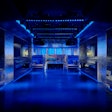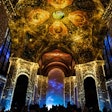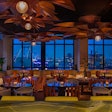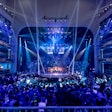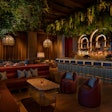
Fern Mallis has overseen New York's Fashion Week for the past 11 years as the executive director of 7th on Sixth. Mallis took that post while leading the Council of Fashion Designers of America (CFDA), and when the industry trade group sold 7th on Sixth (the arm that produced the shows) to sports and modeling management company IMG last year, she left the CFDA to continue working with the shows. This season, Mercedes-Benz Fashion Week runs from February 8 to 15.
BiZBash: The CFDA sold 7th on Sixth to IMG a year ago. How has that changed the planning of the shows?
Mallis: It hasn't changed that much. What is different now is that we have the resources to pick the brains, and get more advice from people who have planned numerous other big events.
Last season's Fashion Week was halted by the September 11 attacks. How has planning this season's shows changed since then?
We are certainly a changed people and society, and like every industry, ours was changed by 9/11. Our planning was done in a very different climate. We had to find out what the designers thought and felt, whether they wanted to do a show, and in some cases, whether their businesses are surviving. We redesigned the venues to express the intimacy designers wanted, and scaled down from four to two venues. People wanted the shows to have less hoopla, a lot less hype. It's more about the idea that this is our business and let's have it be seen by the people who are in the business. People wanted more of a sense of control.
Our biggest venue before was the Tent, which sat 1,200, and held up to 1,400, including people standing. This season, the biggest venue, the Theater, seats 688 and has limited standing room. Our next venue is the Gallery, which was designed to resemble a showroom, to reflect designers' wishes to show in what they view as their "safe haven." It seats 525 to 530, and many showing in that venue would normally have 900 to 1,200.
We also have the Mercedes-Benz Fashion Week SoHo, which will feature about 25 or 26 designers in the Puck Building. Clearly, it's a less expensive venue, when you figure that you're starting with four walls and electricity, plumbing and other fixtures.
The shows have become increasingly extravagant and drawn more and more attention in recent years. Will we see a change in the way designers present their collections this year?
I'm not sure I can answer that for all designers. Some people had things they were prepared to do last season, and they are prepared to bring them out again this year since they never showed. For others, the production values are changing a bit, but I think some will still do interesting things with their shows. The keyword is "appropriate," for each designer.
What have you been hearing from designers, buyers and journalists about traveling to New York for the shows?
We've registered all the major players from the regional and international press and buyers. If anything, we've heard an enormous groundswell of support and enthusiasm for New York. Lots of people were in town last season and were terribly impressed by how New York responded. A lot of people felt badly for the industry.
Part of the excitement surrounding Fashion Week is the parties. What's the party schedule like this year?
I'm hearing bits and pieces, but there are lots and lots of parties and events to go to. People are definitely feeling the need to celebrate and be happy.
As for the style of the events, I can't address the ostentation value, but I think there are people who legitimately have a reason to celebrate. This is an industry that continues to go on, unlike a sporting event, which can be rescheduled. Fashion has a cycle. Things have to keep going.
Posted 02.08.02
Photo by Patrick Demarchelier; courtesy of IMG
BiZBash: The CFDA sold 7th on Sixth to IMG a year ago. How has that changed the planning of the shows?
Mallis: It hasn't changed that much. What is different now is that we have the resources to pick the brains, and get more advice from people who have planned numerous other big events.
Last season's Fashion Week was halted by the September 11 attacks. How has planning this season's shows changed since then?
We are certainly a changed people and society, and like every industry, ours was changed by 9/11. Our planning was done in a very different climate. We had to find out what the designers thought and felt, whether they wanted to do a show, and in some cases, whether their businesses are surviving. We redesigned the venues to express the intimacy designers wanted, and scaled down from four to two venues. People wanted the shows to have less hoopla, a lot less hype. It's more about the idea that this is our business and let's have it be seen by the people who are in the business. People wanted more of a sense of control.
Our biggest venue before was the Tent, which sat 1,200, and held up to 1,400, including people standing. This season, the biggest venue, the Theater, seats 688 and has limited standing room. Our next venue is the Gallery, which was designed to resemble a showroom, to reflect designers' wishes to show in what they view as their "safe haven." It seats 525 to 530, and many showing in that venue would normally have 900 to 1,200.
We also have the Mercedes-Benz Fashion Week SoHo, which will feature about 25 or 26 designers in the Puck Building. Clearly, it's a less expensive venue, when you figure that you're starting with four walls and electricity, plumbing and other fixtures.
The shows have become increasingly extravagant and drawn more and more attention in recent years. Will we see a change in the way designers present their collections this year?
I'm not sure I can answer that for all designers. Some people had things they were prepared to do last season, and they are prepared to bring them out again this year since they never showed. For others, the production values are changing a bit, but I think some will still do interesting things with their shows. The keyword is "appropriate," for each designer.
What have you been hearing from designers, buyers and journalists about traveling to New York for the shows?
We've registered all the major players from the regional and international press and buyers. If anything, we've heard an enormous groundswell of support and enthusiasm for New York. Lots of people were in town last season and were terribly impressed by how New York responded. A lot of people felt badly for the industry.
Part of the excitement surrounding Fashion Week is the parties. What's the party schedule like this year?
I'm hearing bits and pieces, but there are lots and lots of parties and events to go to. People are definitely feeling the need to celebrate and be happy.
As for the style of the events, I can't address the ostentation value, but I think there are people who legitimately have a reason to celebrate. This is an industry that continues to go on, unlike a sporting event, which can be rescheduled. Fashion has a cycle. Things have to keep going.
Posted 02.08.02
Photo by Patrick Demarchelier; courtesy of IMG










